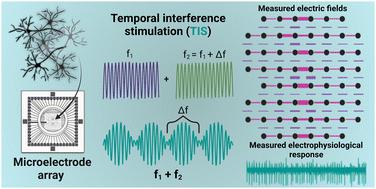Our official English website, www.x-mol.net, welcomes your feedback! (Note: you will need to create a separate account there.)
Electric field temporal interference stimulation of neurons in vitro
Lab on a Chip ( IF 6.1 ) Pub Date : 2024-07-12 , DOI: 10.1039/d4lc00224e Annika Ahtiainen 1 , Lilly Leydolph 2 , Jarno M. A. Tanskanen 1 , Alexander Hunold 2, 3 , Jens Haueisen 2, 4 , Jari A. K. Hyttinen 1
Lab on a Chip ( IF 6.1 ) Pub Date : 2024-07-12 , DOI: 10.1039/d4lc00224e Annika Ahtiainen 1 , Lilly Leydolph 2 , Jarno M. A. Tanskanen 1 , Alexander Hunold 2, 3 , Jens Haueisen 2, 4 , Jari A. K. Hyttinen 1
Affiliation

|
Electrical stimulation (ES) techniques, such as deep brain and transcranial electrical stimulation, have shown promise in alleviating the symptoms of depression and other neurological disorders in vivo. A new noninvasive ES method called temporal interference stimulation (TIS), possesses great potential as it can be used to steer the stimulation and possibly selectively modulate different brain regions. To study TIS in a controlled environment, we successfully established an in vitro ‘TIS on a chip’ setup using rat cortical neurons on microelectrode arrays (MEAs) in combination with a current stimulator. We validated the developed TIS system and demonstrated the spatial steerability of the stimulation by direct electric field measurements in the chip setup. We stimulated cultures of rat cortical neurons at 28 days in vitro (DIV) by two-channel stimulation delivering 1) TIS at 653 Hz and 643 Hz, resulting in a 10 Hz frequency envelope, 2) low-frequency stimulation (LFS) at 10 Hz and 3) high-frequency stimulation (HFS) at 653 Hz. Unstimulated cultures were used as control/sham. We observed the differences in the electric field strengths during TIS, HFS, and LFS. Moreover, HFS and LFS had the smallest effects on neuronal activity. Instead, TIS elicited neuronal electrophysiological responses, especially 24 hours after stimulation. Our ‘TIS on a chip’ approach eludicates the applicability of TIS as a method to modulate neuronal electrophysiological activity. The TIS on a chip approach provides spatially steerable stimuli while mitigating the effects of high stimulus fields near the stimulation electrodes. Thus, the approach opens new avenues for stimulation on a chip applications, allowing the study of neuronal responses to gain insights into the potential clinical applications of TIS in treating various brain disorders.
中文翻译:

体外神经元电场时间干扰刺激
电刺激(ES)技术,例如深部脑电刺激和经颅电刺激,在减轻体内抑郁症和其他神经系统疾病的症状方面显示出了希望。一种新的非侵入性 ES 方法称为时间干扰刺激 (TIS),具有巨大的潜力,因为它可用于引导刺激并可能选择性地调节不同的大脑区域。为了在受控环境中研究 TIS,我们使用微电极阵列 (MEA) 上的大鼠皮层神经元与电流刺激器结合,成功建立了体外“芯片上的 TIS”设置。我们验证了开发的 TIS 系统,并通过芯片设置中的直接电场测量证明了刺激的空间可操纵性。我们在体外 (DIV) 28 天时通过双通道刺激刺激大鼠皮质神经元培养物,提供 1) 653 Hz 和 643 Hz 的 TIS,产生 10 Hz 频率包络,2) 10 Hz 的低频刺激 (LFS) Hz 和 3) 653 Hz 的高频刺激 (HFS)。未刺激的培养物用作对照/假手术。我们观察了 TIS、HFS 和 LFS 期间电场强度的差异。此外,HFS 和 LFS 对神经元活动的影响最小。相反,TIS 引发了神经元电生理反应,尤其是在刺激后 24 小时。我们的“芯片上 TIS”方法阐明了 TIS 作为调节神经元电生理活动的方法的适用性。芯片上的 TIS 方法提供空间可操纵的刺激,同时减轻刺激电极附近高刺激场的影响。 因此,该方法为芯片上的刺激应用开辟了新途径,使神经元反应的研究能够深入了解 TIS 在治疗各种脑部疾病中的潜在临床应用。
更新日期:2024-07-12
中文翻译:

体外神经元电场时间干扰刺激
电刺激(ES)技术,例如深部脑电刺激和经颅电刺激,在减轻体内抑郁症和其他神经系统疾病的症状方面显示出了希望。一种新的非侵入性 ES 方法称为时间干扰刺激 (TIS),具有巨大的潜力,因为它可用于引导刺激并可能选择性地调节不同的大脑区域。为了在受控环境中研究 TIS,我们使用微电极阵列 (MEA) 上的大鼠皮层神经元与电流刺激器结合,成功建立了体外“芯片上的 TIS”设置。我们验证了开发的 TIS 系统,并通过芯片设置中的直接电场测量证明了刺激的空间可操纵性。我们在体外 (DIV) 28 天时通过双通道刺激刺激大鼠皮质神经元培养物,提供 1) 653 Hz 和 643 Hz 的 TIS,产生 10 Hz 频率包络,2) 10 Hz 的低频刺激 (LFS) Hz 和 3) 653 Hz 的高频刺激 (HFS)。未刺激的培养物用作对照/假手术。我们观察了 TIS、HFS 和 LFS 期间电场强度的差异。此外,HFS 和 LFS 对神经元活动的影响最小。相反,TIS 引发了神经元电生理反应,尤其是在刺激后 24 小时。我们的“芯片上 TIS”方法阐明了 TIS 作为调节神经元电生理活动的方法的适用性。芯片上的 TIS 方法提供空间可操纵的刺激,同时减轻刺激电极附近高刺激场的影响。 因此,该方法为芯片上的刺激应用开辟了新途径,使神经元反应的研究能够深入了解 TIS 在治疗各种脑部疾病中的潜在临床应用。












































 京公网安备 11010802027423号
京公网安备 11010802027423号